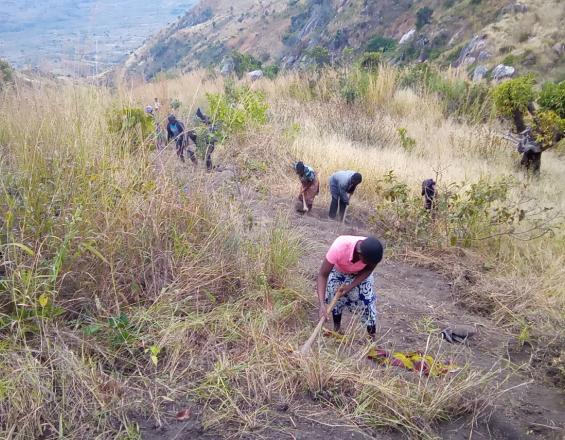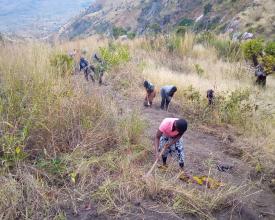Restauration des forêts dégradées grâce à la RNA

En soutien à la stratégie nationale de restauration des paysages forestiers du gouvernement du Malawi et au plan d'action FLR du conseil du district de Dedza, le département des forêts (DoF), avec le soutien de l'activité Modern Cooking for Healthy Forests, a engagé les communautés locales en utilisant des données (par exemple, de l'évaluation FLR nationale, de l'inventaire forestier national et de l'évaluation de la déforestation) pour donner la priorité aux points chauds de dégradation dans les réserves forestières sélectionnées et les paysages adjacents. Les points chauds de dégradation sont des points focaux pour les interventions de "restauration" - y compris un certain nombre de points chauds dans/autour de la réserve forestière de Mua-Livulezi.
Contexte
Défis à relever
Entre 2000 et 2020, la réserve forestière de Mua-Livulezi a été largement déboisée et dégradée, principalement en raison de la production illégale et non durable de charbon de bois pour la capitale Lilongwe (et d'autres zones périurbaines voisines). En outre, après que certaines zones aient été déboisées pendant des années, des membres de la communauté ont empiété sur la zone protégée et ont commencé à y ouvrir de nouvelles exploitations agricoles. Les incendies répétés associés à la préparation des terres agricoles et au défrichement ont eu un impact négatif sur la régénération. Les communautés situées en aval ont subi l'érosion des sols, ce qui a entraîné une perte de fertilité des sols, une baisse de la production agricole et des périodes d'insécurité alimentaire de plus en plus fréquentes.
Emplacement
Traiter
Résumé du processus
Un leadership local fort est essentiel pour catalyser le soutien à la mise en œuvre. Cependant, le retour d'information et les preuves de la mise en œuvre sont importants pour démontrer les progrès accomplis et pour maintenir l'engagement des acteurs. Lorsque l'AT a dirigé les efforts visant à éliminer les empiéteurs, cette "action" a incité les autres parties à l'accord de la FCM à rendre des comptes et à faire leur part du travail.
Blocs de construction
Tirer parti d'un leadership local fort et de partenariats avec le gouvernement et d'autres acteurs
Les éléments suivants ont contribué au succès de la restauration réalisée à ce jour.
- Un leadership local fort : le leadership fort des autorités traditionnelles et des comités locaux a facilité la participation, l'engagement et l'adhésion.
- Partenariat avec les services gouvernementaux : Le gouvernement du Mozambique fournit une formation et un soutien en temps opportun
- Partenariat avec des ONG locales et internationales.
L'organisation a soutenu les bénéficiaires en leur fournissant des ressources, notamment des données, une formation/un renforcement des capacités et, dans certains cas, des outils.
Facteurs favorables
Les facteurs qui ont permis le succès à ce jour sont notamment la reconnaissance du fait que les dirigeants locaux sont les agents de développement les plus dignes de confiance. Sans l'adhésion et le leadership fort de l'autorité traditionnelle (et des chefs de village de son groupe), il aurait été extrêmement difficile, voire impossible, d'obtenir l'adhésion des communautés.
Leçon apprise
Les enseignements tirés à ce jour sont les suivants :
- L'information, la sensibilisation et le plaidoyer sont essentiels à l'identification et à la résolution des problèmes par la communauté, et sont des conditions préalables à la participation de la communauté aux "solutions".
- La participation de la communauté au travail de développement permet de réduire les coûts de mise en œuvre des activités.
- Les partenariats et la collaboration avec le conseil de district et le comité de développement de la zone, ainsi qu'avec les organisations non gouvernementales, sont essentiels pour obtenir le soutien technique nécessaire, par exemple en ce qui concerne l'évaluation des risques naturels et la construction de coupe-feu.
Ressources
La responsabilité est la clé de la gouvernance et de la gestion
Afin de promouvoir une meilleure gouvernance et une meilleure gestion, le DoF et le MCHF ont soutenu l'élaboration d'un accord tripartite de cogestion forestière entre le DoF, le conseil de district et les communautés locales (représentées par les assistants techniques). Rôles et responsabilités - l'inclusion de rôles et d'engagements spécifiques de la part des acteurs de soutien (y compris les services de police du Malawi, le ministère de la Justice, etc.
Facteurs favorables
L'accord de cogestion forestière s'appuie sur un plan de gestion forestière, élaboré à partir des données de l'IFN et d'une série de consultations communautaires. Ce plan a également permis d'identifier et de classer par ordre de priorité les points chauds de dégradation/restauration.
Leçon apprise
La preuve de la mise en œuvre est importante pour inciter et motiver les partenaires à continuer d'investir dans la cogestion forestière.
Impacts
Des sous-ensembles de points chauds de dégradation (appelés points chauds de dégradation/restauration) ont été "traités" par les communautés à l'aide de coupe-feu et de RNA, après une formation dispensée par le ministère des Forêts et le projet MCHF. Alors que le Malawi passe à la saison sèche, on constate une diminution des incendies dommageables dans les zones de dégradation/restauration traitées. En outre, la régénération dans les zones traitées progresse visiblement plus vite que dans les sections adjacentes non traitées des points chauds de dégradation, ce qui démontre le potentiel de la forêt pour sa fonctionnalité écologique (et aide à informer l'analyse de rentabilité de la RNA). Entre 2021 et aujourd'hui, 450 hectares au total ont été restaurés.
En outre, il convient de noter que de plus en plus de personnes sont désormais impliquées dans les activités de restauration, ce qui reflète peut-être la qualité de l'engagement et de la sensibilisation, ainsi que les avantages perçus de la restauration des fonctions écologiques clés qui profitent à ceux qui restaurent les zones dégradées.
Bénéficiaires
- Comité de gestion du bloc de Nadzikhale (BMC)
- Comité de gestion du bloc de Ngonoonda
- Kamenya Gwaza BMC
- Comité de gestion de bloc de Kadzungu
Objectifs de développement durable
Histoire

Comme nous l'avons mentionné plus haut, dans certaines parties de la réserve, après le défrichage pour la production de charbon de bois, des personnes se sont installées dans des zones agricoles ouvertes. À la suite de plusieurs années de précipitations inférieures à la normale et de périodes de pluies intenses et d'inondations, de plus en plus de personnes ont empiété sur la réserve pour cultiver des terres vierges, laissant certaines parties de la réserve dénudées, ce qui a entraîné une augmentation du ruissellement, une érosion des sols en aval, une perte de fertilité des sols et une baisse de la productivité agricole (ainsi qu'une augmentation de la sécurité alimentaire).
En 2020, le gouvernement du Malawi, avec le soutien de l'USAID et de l'UKaid, a cofinancé le projet Modern cooking for Healthy Forest (MCHF) et a commencé à sensibiliser les communautés aux impacts en aval de la déforestation et de la dégradation. Peu après, les partenaires ont commencé à former les communautés de l'autorité traditionnelle Kamenya Gwaza à la régénération naturelle assistée et à la prévention et à la gestion des incendies. Les membres de la communauté sont organisés en BMC, dans le but de mettre en œuvre des activités de RPF dans les points chauds de dégradation identifiés. Ces BMC ont continué à mettre en œuvre des activités de restauration dans ces points chauds. L'une des premières activités mises en œuvre par les BMC a consisté à sensibiliser les empiéteurs de la réserve protégée aux impacts de la dégradation des terres forestières. Ces efforts ont permis à 60 % des empiéteurs de quitter la zone protégée. Par la suite, l'autorité traditionnelle s'est organisée pour que les empiéteurs restants soient retirés de la réserve forestière. Les zones qui ont été défrichées et cultivées sont restées "en jachère" en 2021, mais des plantes en régénération ont commencé à réapparaître et les BMC ont mené des activités d'ANR et de prévention des incendies dans ces zones.







